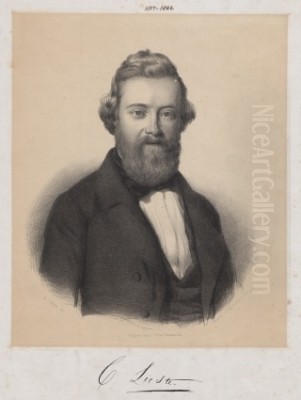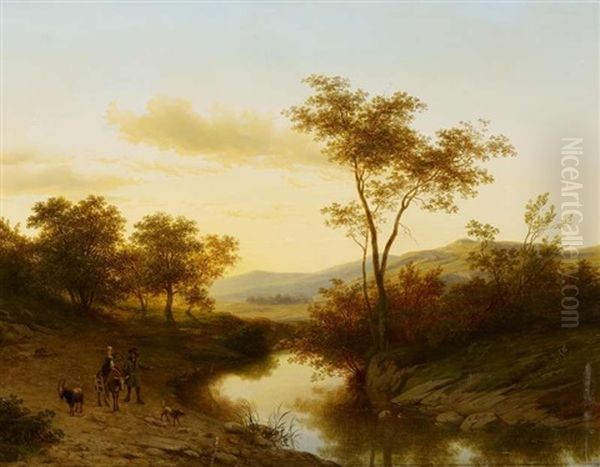
Cornelis Lieste (1817-1861) stands as a notable figure in the rich tapestry of 19th-century Dutch art. A dedicated painter of the Romantic tradition, Lieste carved a niche for himself with his evocative portrayals of the Dutch countryside, capturing its serene beauty and atmospheric depth. His works, often bathed in the soft light of dawn or the melancholic glow of twilight, resonate with a profound appreciation for nature and a technical finesse that earned him recognition among his peers and continues to attract art enthusiasts today. Born in Haarlem, a city with a storied artistic heritage, Lieste was immersed in an environment conducive to artistic development from a young age.
Early Life and Artistic Formation in Haarlem
Born on October 26, 1817, in Haarlem, Netherlands, Cornelis Lieste grew up in a region that had been a crucible of artistic innovation for centuries, particularly during the Dutch Golden Age. This historical backdrop undoubtedly played a role in shaping his artistic inclinations. Haarlem, with its picturesque surroundings and established art scene, provided fertile ground for young talents. Lieste received his foundational art education in his hometown, a common practice for aspiring artists of the period who often began their training under local masters or at local academies.
While specific details of his earliest tutelage are not extensively documented, it is known that he honed his skills diligently, focusing on the landscape genre that would define his career. The artistic environment of Haarlem at the time was still echoing with the legacy of 17th-century masters like Jacob van Ruisdael and Meindert Hobbema, whose dramatic and meticulously detailed landscapes had set a high bar. The emerging Romantic movement, however, was infusing new emotional and subjective perspectives into landscape painting, a trend Lieste would embrace.
The Embrace of Romanticism

The early to mid-19th century in Europe was dominated by Romanticism, an artistic and intellectual movement that emphasized emotion, individualism, and the glorification of the past and nature. In landscape painting, this translated into a departure from purely topographical representation towards more subjective and atmospheric interpretations. Dutch Romantic painters, Lieste among them, sought to capture not just the visual accuracy of a scene but also its mood, its poetic essence, and the sublime power of nature.
Lieste’s work fits comfortably within this paradigm. He was particularly drawn to the tranquil aspects of the Dutch landscape – its expansive meadows, winding rivers, dense woodlands, and the ever-changing sky. His paintings often evoke a sense of peace and contemplation, inviting the viewer to immerse themselves in the quiet beauty of the natural world. This approach was characteristic of a generation of Dutch artists who found renewed inspiration in their native scenery, often imbuing it with a sense of national pride and nostalgic sentiment.
Influences and Artistic Development
A significant influence on Cornelis Lieste, and indeed on many Dutch Romantic landscape painters, was the towering figure of Barend Cornelis Koekkoek (1803-1862). Often hailed as the "Prince of Landscape Painters," Koekkoek was renowned for his meticulously detailed and idealized forest scenes and panoramic views. Lieste is known to have studied for a period with Koekkoek, likely in Kleve, Germany, where Koekkoek had established a drawing academy that attracted students from across Europe. This association would have been formative, exposing Lieste to Koekkoek’s masterful technique and his Romantic vision of nature.
Another, more distant but pervasive, influence often cited in relation to Lieste is the 17th-century French classical landscape painter Claude Lorrain (1600-1682). Lorrain was celebrated for his idealized landscapes bathed in a soft, golden light, creating harmonious and poetic compositions. Art historians have noted parallels between Lieste's handling of light and atmosphere and Lorrain's, particularly in Lieste's ability to suffuse his scenes with a gentle, luminous quality that enhances their tranquility. This comparison underscores Lieste's skill in manipulating light to evoke specific moods and times of day.
Lieste also spent time in Oosterbeek, a village near Arnhem that became known as the "Dutch Barbizon" due to its popularity with landscape painters seeking to work directly from nature. From 1854 to 1856, his presence there would have placed him in the company of other artists who shared his passion for plein air observation and the Romantic depiction of the local scenery. Figures like Johannes Warnardus Bilders (1811-1890) were central to the Oosterbeek School, and their focus on the unadulterated Dutch landscape would have resonated with Lieste's own artistic pursuits.
Artistic Style and Thematic Focus
Cornelis Lieste’s artistic style is characterized by a delicate balance between realistic observation and Romantic idealization. He possessed a keen eye for the nuances of the Dutch landscape, from the texture of foliage to the subtle gradations of color in the sky. His brushwork was typically refined, allowing for a high degree of detail without sacrificing the overall atmospheric unity of his compositions.
A recurring theme in Lieste’s oeuvre is the depiction of specific times of day, particularly sunset and moonlit scenes. These moments, with their dramatic lighting and inherent sense of transition, provided ample opportunity for Romantic expression. He masterfully captured the warm hues of a setting sun casting long shadows across a meadow, or the silvery light of the moon illuminating a quiet woodland path. Water, whether in the form of placid rivers, reflective ponds, or marshy wetlands, also featured prominently, allowing him to explore the interplay of light and reflection.
His compositions are often carefully structured, leading the viewer’s eye into the depth of the landscape through winding paths or receding planes. Figures, when present, are usually small and integrated into the scenery, serving to emphasize the scale and dominance of nature rather than acting as primary subjects. This approach aligns with the Romantic sensibility of humanity's place within the larger natural order.
Signature Works
Several works stand out as representative of Cornelis Lieste's artistic achievements. One of his most celebrated paintings is Landschaft mit Mondsichel (Landscape with Crescent Moon). This piece exemplifies his skill in capturing the ethereal beauty of a moonlit night. The subtle illumination, the deep shadows, and the overall sense of stillness create a powerfully evocative and poetic atmosphere. Such nocturnal scenes were a popular subgenre within Romanticism, appealing to the movement's fascination with mystery, introspection, and the sublime.
Another important work is Heide bij avond (Heath at Evening or Evening on the Heath), painted between 1837 and 1859. This painting showcases his ability to render the unique character of heathland landscapes, a common feature in parts of the Netherlands. The depiction of the fading light of evening imbues the scene with a melancholic yet peaceful quality. The vastness of the heath under a wide expanse of sky is a typical Romantic motif, suggesting both the beauty and the untamed aspect of nature.
Abendstimmung am Fluss (Evening Mood on the River) is another example of his preoccupation with twilight scenes. Here, Lieste would have focused on the reflections in the water, the silhouettes of trees against the dimming sky, and the overall tranquil ambiance of a river at dusk. These works demonstrate his consistent ability to translate his observations of nature into emotionally resonant images. His panoramic views of sun-drenched pastures also garnered considerable acclaim, showcasing his versatility in depicting different lighting conditions and landscape types.
Lieste as a Teacher and His Artistic Circle
Beyond his own artistic production, Cornelis Lieste played a role in nurturing the next generation of painters. He was a respected teacher, and several artists who went on to achieve recognition studied under him. Among his pupils was Hendrik Kruseman van Elten (1829-1904), who began his studies with Lieste in Haarlem around 1844 before later moving to New York and becoming a notable member of the Hudson River School-influenced American landscape tradition. Van Elten's early grounding under Lieste would have instilled in him the principles of Romantic landscape painting.
Another significant student was Paul Joseph Constantin Gabriël (1828-1903). Gabriël studied with Lieste in Haarlem and later became a prominent figure in the Hague School, a movement that evolved from Dutch Romanticism towards a more realistic and atmospheric depiction of the landscape. Gabriël's time with Lieste would have provided him with a solid foundation in landscape techniques. Through Gabriël, Lieste is indirectly connected to other Hague School luminaries like Anton Mauve (1838-1888), a cousin-in-law and early influence on Vincent van Gogh, and Willem Maris (1844-1910).
Lieste's professional network would have also included contemporaries who shared his Romantic inclinations. Artists like Andreas Schelfhout (1787-1870), who was a teacher to B.C. Koekkoek and a leading figure in Dutch Romantic landscape painting, set the stage for painters like Lieste. Willem Roelofs (1822-1897), another key figure who bridged Romanticism and the Hague School, and who also spent time in Oosterbeek, would have been part of the broader artistic milieu in which Lieste operated. Other landscape painters of the era, such as Johannes Bosboom (1817-1891), known more for his church interiors but also a Hague School member, and Jozef Israëls (1824-1911), a leading figure of the Hague School, contributed to the vibrant artistic climate of the Netherlands during Lieste's lifetime. Even artists focusing on different subjects, like Wouter Verschuur (1812-1874) with his famous horse paintings, were part of this interconnected art world.
Recognition, Character, and Later Years
Cornelis Lieste's talent did not go unnoticed during his lifetime. He exhibited his works regularly and gained a reputation for his skillful and sensitive portrayals of the Dutch landscape. In 1861, the year of his untimely death, he received a modest award of 30 Dutch guilders from the government, a token of recognition for his artistic contributions. While perhaps not a grand prize, it signifies that his work was valued by contemporary authorities.
Beyond his artistic achievements, Lieste was reportedly held in high regard for his personal qualities. Historical accounts describe him as a "man of noble character," suggesting integrity and a respected standing within his community. Such personal attributes often contributed to an artist's reputation and their ability to attract students and patrons.
His period in Oosterbeek (1854-1856) was likely a productive and inspiring time, allowing for direct engagement with nature and interaction with fellow landscape artists. However, his career was relatively short. Cornelis Lieste passed away on July 24, 1861, in his native Haarlem, at the age of only 43. His early death cut short a promising artistic journey, leaving one to speculate on how his style might have further evolved had he lived longer, perhaps engaging more directly with the emerging trends that led to the Hague School.
Legacy and Conclusion
Cornelis Lieste left behind a body of work that firmly places him within the tradition of Dutch Romantic landscape painting. While perhaps not as internationally renowned as his mentor B.C. Koekkoek or some leading figures of the subsequent Hague School like Hendrik Willem Mesdag (1831-1915) or Jacob Maris (1837-1899), Lieste's contribution is significant. His paintings are admired for their technical skill, their subtle rendering of light and atmosphere, and their genuine affection for the Dutch countryside.
His works can be found in various public and private collections, and they continue to be appreciated for their tranquil beauty and their embodiment of Romantic ideals. As a teacher, he influenced artists like Hendrik Kruseman van Elten and Paul Joseph Constantin Gabriël, thereby contributing to the continuity and evolution of Dutch landscape painting.
In the broader narrative of Dutch art, Cornelis Lieste represents an important link in the chain, upholding the strong tradition of landscape painting while infusing it with the sensibilities of his time. His dedication to capturing the poetic essence of nature, particularly the serene and often melancholic beauty of the Dutch meadows and woodlands at the transitional hours of day, ensures his enduring appeal. He remains a testament to the quiet power of Romanticism and its ability to find profound beauty in the familiar landscapes of home. His legacy is that of a skilled and sensitive artist who, through his canvases, invites us to pause and appreciate the enduring allure of the natural world.